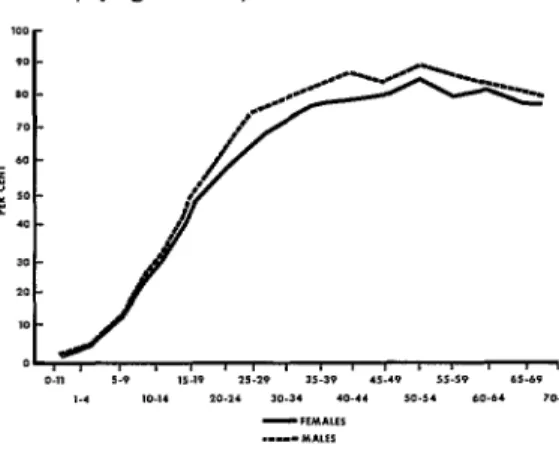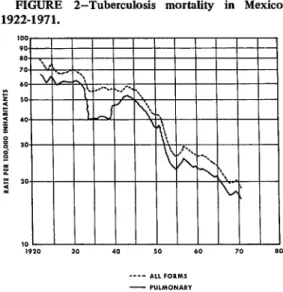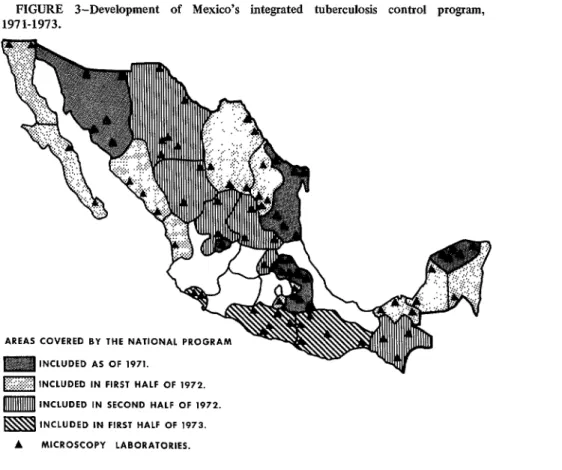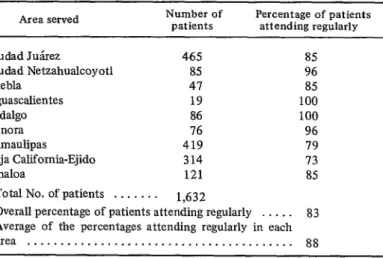THE BASIS FOR A TUBERCULOSIS CONTROL PROGRAM IN MEXICO1
Rafael Senties V., M.D.;2 Arturo Ortiz Cruz, M.D.;3 Jorge Bonilla, M.D.;4 Hilario Rodarte, M .D .i4 and Antonio Escobedo, M.D.5
Mexico is currently reorganizing its anti-tuberculosis activities, changing the focus of government vaccination, case-finding, and treatment efforts. The aim is to improve the services provided by integrating anti-tuberculosis work in to the general activities of the national health program. The article that follows describes this reorganization.
Introduction
Roughly 120,000 persons over 15 years of age in Mexico are believed to have tubercu- losis.6 About 50 per cent of these have been registered with the nation’s health services, the location of the remainder being unknown. Furthermore, in the past a large share of those registered have abandoned drug therapy before the end of six months, and only about half have received the benefits of the full one-year course of treatment.
This general situation has been accompanied by high levels of early exposure to the disease. For example, surveys made by the Ministry of Health and Welfare and the Bureau of School Hygiene in 1963 indicated a level of exposure reaching 15.3 per cent in the O-14 age group- based on a skin reaction of 6 mm or more to 2 Units of PPD-tuberculin (RT 23),7 as shown in Figure 1.
Among the population as a whole it is ‘Condensed version of the article appearing in Spanish in the Boletz’n de la Oficina Sanitaria Pana- kricana, Volume LXXVI, No. 6, 1974. Based on material presented at the First National Health Con- vention of Mexico held at Mexico City in July 1973. 2Chief, National Campaign Against Tuberculosis (NCT), Leibnitz 32, Mexico, D.F., Mexico.
3Head of the Epidemiology Department, NCT. 4Member, Medical Department Group, NCT. 5Member, Medical Evaluation Department, NCT. 6Defining a tuberculosis case as a person who expectorates M. tuberculosis has resulted in a revl- sion of Mexico’s case estimates. Past research using X-ray techniques had found a process suggestive of tuberculosis in about 1.4 per cent of the population. However, subsequent bacteriologic research showed active processes in only about 0.4 per cent of the population over 15 years of age. The case estimate cited (120,000) is based on the latter finding.
estimated that 36,000 new cases arise each year (4 for each death), and that only about 18,000 of these are reported.
As in all countries, tuberculosis mortality in Mexico has gradually declined, largely as a result of the development and implementation of anti-bacterial treatment with streptomycin and isorQazid (see Figure 2). The disease cur- rently ranks ninth among causes of death, having accounted for 1.98 per cent of all deaths in 197 1. Pulmonary forms were responsible for 88.6 per cent of these deaths, a relative percentage which has not varied greatly in recent years.
Despite this gradual improvement, three serious problems can readily be identified. These are (1) the large number of undetected
FIGURE l-Positive tuberculin test reactors in Mexico, by age and sex, 1962-1963.
100
r
7A large batch of PPD-tuberculin prepared at the Statens Serumlnstitut, Copenhagen, by agreement with UNICEF and WHO, which was first issued in 1958. See Bull WHO 19: 829-843, 1958.
312 PAHO BULLETIN . VoZ. VIII, No. 4, 19 74
FIGURE 2-Tuberculosis mortality in Mexico, 1922-1971.
cases, both old and new; (2) the low level of benefits produced by drug therapy; and (3) the high level of public exposure to early infection.
In response to these problems, Mexico has developed a national program directed at achieving a satisfactory solution in the shortest possible time. Major features of the program include the following:
l Intensification of case-finding efforts,
based on direct microscopic examination of sputum specimens from respiratory sympto- matics and participation of all available health services in the collection process.
l Improvement of the results obtained from
chemotherapy through use of standard super- vised biweekly regimens, with the goal of producing bacteriologic conversion in up to 90 per cent of the new cases treated. All health services are to participate in providing this treatment and in determining whether bacterio- logic conversion has occurred.
l Protection of at least 75 per cent of the
population under age 15 by direct BCG vaccina- tion, and maintenance of this level of coverage by continued vaccination programs.
An appropriate and continuing educational effort will be needed to acquaint a variety of personnel with the new focus of the tubercu- losis program and to prepare them for their role
in coordinating the anti-tuberculosis activities of all the institutions involved. It will also be important to acquaint physicians in private practice with the program, in order that they not regard it as a competing source of treat- ment, but rather as an activity supporting the diagnosis and treatment of their patients. Case-finding
Since only about 50 per cent of all cases are known, and only about 50 per cent of all new cases are reported each year, it is imperative that both the effectiveness and the intensity of the nation’s case-finding efforts be increased. This will be required in order for transmission cycles to be interrupted and reservoirs of infection identified and eliminated.
Fortunately, a worldwide change in case- finding procedures has gradually been accom- plished that is highly advantageous to countries such as ours with limited resources, a weak health structure, and a widely dispersed popula- tion. The traditional X-ray examination method has lost the role once assigned to it by reason of the following disadvantages:
l It is not readily accessible to people in
suburban and rural areas.
l Because it is a cyclical, or frequently a
one-time procedure, it provides no underpin- ning of continuity for case-finding efforts.
l It requires movement of persons with
suspected cases, often for a considerable dis- tance.
l The cost is high (approximately 1,000
pesos per case detected).8
l The yield is low (averaging 0.2 per cent
among persons 15 and over).
l The majority of cases detected are
symptomatic, i.e. readily detectable by other means.
l Maintenance of the test units is difficult
and costly.
l Confirmation of the diagnosis requires a
sputum examination.
Senties, et al. . TUBERCULOSIS CONTROL IN MEXICO 313
scopic examination of sputum specimens from respiratory symptomatics, has therefore been sought and developed. This procedure has the following advantages: it is accessible to any urban, suburban, or rural population group; it provides continuity for the case-finding pro- gram; if can be performed at the patient’s home and does not require moving suspected cases; virtually all health personnel, even volunteer workers, can collect the necessary sputum specimen; the cost is low; and a positive finding establishes the diagnosis.
It must be emphasized that this case-finding procedure relies initially on excellent direct microscopy, since sputum culture examination should not: be considered a preliminary case- t&ling method. Use of the latter method represents a second level of case-finding, to be applied once the first level has been effectively implemented throughout the system.
Within this context, it has been found worthwhile to use properly trained paramedical personnel, i.e. microscopists, in lieu of profes- sional staff for preparation and reading of smears. These workers have the equivalent of a secondary school education and have received an intensive four-week training course in mi- croscopy. We have found them to be highly motivated and extremely effective. Capable of carrying out some 8,000 examinations per year, they nonetheless require only one-third the salary of professional personnel. In sum, they have served as a mainstay of our integrated program.
A prime objective of this change in case-find- ing methods has been to permit integration of the nation’s 32 regional tuberculosis programs into the activities of its 2,084 health centers. In planning a program at the national level for each area, the number of people served and the estimated number of respiratory symptomatics are weighed against the number of available sputum collection units and microscopy cen- ters, taking into account distances, transport facilities, and the average time needed to ship a sputum specimen or smear.
Development of the national program is shown in Figure 3. By 30 June 1973, tuberculo-
sis control activities had been incorporated into the work of 1,509 health centers. In addition, the number of microscopy laboratories had grown to 86. As of that time, examination of sputum specimens from 60,254 persons expe- riencing a chronic cough had shown 4,762 (7.9 per cent) to have bacteriologically positive cases of tuberculosis. The accuracy of the work performed was determined by close supervision involving review of all positive readings and 10 per cent of all negative readings. The result was 92 per cent agreement in the reading of 8,475 slides.
Controlled Case-treatment
Most countries, including Mexico, need to increase the efficacy of chemotherapy through improved organization of ambulatory treat- ment. There is no doubt which drugs to employ; rather, the need is to establish a treatment system that will cause all patients with diagnosed cases to complete their treat- ment with the drugs selected, in the necessary dosage, and for a period never less than one year.
In the past, full advantage has not been taken of the health structure. Moreover, the traditional treatment methods, involving self- administration by the patient, resulted in inter- ruption or abandonment of treatment in about 50 per cent of the cases. At the same time, resource limitations make it necessary to achieve a high rate of success (90 to 95 per cent) in treating primary cases before devoting resources to secondary drug treatment meas- ures.
314 PAHO BULLETIN . Vol. VIII, No. 4, 1974
FIGURE 3-Development of Mexico’s integrated tuberculosis control program, 1971-1973.
AREAS COVERED BY THE NATIONAL PROGRAM
INCLUDED AS OF 1971.
pJgJ INCLUDED IN FIRST HALF OF ,972.
m INCLUDED IN SECOND HALF OF 1972.
INCLUDED IN FIRST HALF OF 1973.
A MICROSCOPY LABORATORIES.
six times the entire budget for the national program, would be required. On the other hand, if we should be able by other means to obtain around 95 per cent conversion with primary treatment, leaving only 5 per cent to be treated with secondary drugs, the cost of such secondary medication would be around 28,284,OOO pesos, a figure that is not beyond the reach of the Ministry of Health and Welfare budget. At the present time the proportion of patients being rendered bacteriologically nega- tive with primary drugs has increased to ap- proximately 70 per cent.
A policy of using funds for partial re-treat- ment, that is, for short-term hospitalization and treatment of patients who are unable to con- tinue treatment with the same medication upon their release, will necessarily promote resist- ance, not only to the primary drugs (which already exists), but to the secondary drugs as well. Accordingly, it is imperative that we treat
L.
only that number of patients for whom a I complete treatment can be provided, ‘ensuring k through control of its administration that full
advantage will be taken of the investment and that the hoped-for benefits will be obtained. These considerations explain why Mexico’s * national tuberculosis control program has adopted the following ambulatory treatment b policy:
0 Provide all health services with complete courses of the drugs used for primary treat- ment, streptomycin and isoniazid; .A
0 Increase chemotherapeutic efficacy to a level of 90 per cent or more by means of cl. treatment supervision and control;
* Strive to increase the number of sick persons protected by offering intermittent bi- weekly courses of treatment at low cost;
~
l Leave treatment administration and con-
Senties, et al. . TUBERCtrLOSIS CONTROL IN MEXICO 315
*
h
? t
*
*
4
*
4 *
l Closely coordinate the patient’s treatment
with other institutions and with his private physician to prevent abandonment of treat- ment;
* Utilize hospital beds for short periods to accommodate patients requiring hospitalization for initiation of re-treatment or other specific reasons, in accord with existing guidelines.
In line with this policy and with the world trend toward improved ambulatory treatment and vaccination, tuberculosis patients should be placed in general hospitals only for specific symptoms and for short periods. Tuberculosis hospitals should be eliminated, and their beds should be converted to general service. In countries such as ours, these beds can thus be used to attend to overriding priorities that pose greater problems than tuberculosis. As shown in Table 1, since 1970 there has been a general reorganization of Mexico’s hospital services along these lines.
It is essential that any program of this nature also take into account the drug regimen to be utilized, the availability of the drugs in ques- tion, the anticipated costs and benefits, and the way the drugs will be administered to the patients. Streptomycin and isoniazid, offered
intermittently in combination, meet the re- quirements of a good treatment regimen, which are: a high rate of bacteriologic conversion (90 per cent), no significant toxic effects, accept- able cost, and uncomplicated administration readily controlled by paramedical or volunteer personnel.
Another important development is elimina- tion of required X-ray procedures for determin- ing whether a patient has been cured. Using a continually positive sputum examination as the criterion of cure makes it easy for the effects of treatment to be monitored via specimens ob- tamed by paramedical or volunteer personnel. There is no question that regular patient attendance at treatment centers results in a high level of conversions. In Ciudad Julrez, Ciudad Netzahualcoyotl, and Puebla-as’well as in other areas more recently incorporated into the pro- gram-similar results were obtained (see Table 2). These indicate an average level of regular attendance exceeding 80 per cent with constant supervision, thus demonstrating that sick peo- ple can be effectively motivated and that they will attend with unexpected regularity. This fact underscores the importance of ensuring that all health services involved have sufficient quantities of the drugs needed to maintain the
TABLE I-Convetsion of Mexico’s tuberculosis hospitals and rest care centers, 1970-1973.
No. of beds
before 1970 Institution Present status
Number of beds
currently devoted to
pneumology
350 265 40 40 162 90 280
90 Teapa, Tabasco Closed
30 Gaymas, Sonora Closed
30 Guanajuato, Guanajuato Closed
25 Parras, Coahuila In process of closing
Hospitals
National Institute of Pneumology, D.F. Izaguirre Rojo Hospital, D.F. Nueva Rosita Unit, Coahuila Monterrey Unit, Nuevo Lebn Zoquipa Hospital, Jalisco Tampico Hospital, Tamaulipas San Fernando Hospital, D.F. Rest care centers
General Hospital 50
Closed 0
General Hospital 5
General Hospital 6
General Hospital -
General Hospital -
.’ ‘,’
316 PAHO BULLETIN . Vol. VIII, No. 4, 1974
TABLE 2-Patient attendance at ambulatory tuberculosis treatment
centers, July 1971June 1972.
Area served Number of patients Percentage of patients attending regularly
Ciudad Jukez 46.5 85
Ciudad Netzahualcoyotl 85 96
Puebla 47 85
Aguascalientes 19 100
Hidalgo 86 100
Sonora 16 96
Tamaulipas 419 79
Baja California-Ejido 314 73
Sinaloa 121 85
Total No. of patients . . . 1,632
Overall percentage of patients attending regularly . . . . 83 Average of the percentages attending regularly in each area . . . 88
treatment regimen, and that the personnel involved offer humane, respectful, and cour- teous treatment to the patients, who have traditionally found themselves cut off emotion- ally-and sometimes physically-from their fam- ilies and society at large.
BCG Vaccination
The large numbers of cases still unidentified and the appreciable numbers of patients who abandon treatment raise the chances for early exposure to the disease. This in turn heightens the risk of developing progressive pulmonary and extrapuhnonary forms, including grave forms such as tubercular meningitis. These circumstances make it necessary to have a preventive vaccination program for young chil- dren in order to reduce the risk that they will become infected. This requirement, viewed by two leading international health organizations9 as an immediate one, has prompted investiga- tion of procedures for “direct” BCG vaccina- tion (vaccination without prior tuberculin test- ing) capable of increasing the number of chil- dren vaccinated, reducing operating costs, and lessening the high drop-out rate that generally occurs when prior tuberculin testing is required. 9p~HO/wH0 and the International Union Against Tuberculosis.
Since then extensive experience has shown the vaccine incapable of producing the disease in sensitive persons or of prompting undesirable focal changes in those with undiagnosed disease.
Accordingly, many countries have imple- mented large-scale vaccination programs. Over the short run these have produced significant levels of protection, resulting in a decrease of at least 80 per cent in progressive forms of the disease among the immunized population.
Senties, et al. . TUBERCULOSIS CONTROL IN MEXICO 317
SUMMARY Mexico currently confronts a tuberculosis problem similar to that encountered by most Latin American countries. There is, fundamen- tally, a need to organize anti-tuberculosis serv- ices and to permanently integrate their specific activities into the general work of the national health program. This presentation describes a major reorganization of Mexico’s anti-tubercu- losis efforts that is directed toward that end. Among other things, this reorganization in- volves the following:
1) Intensification of case-finding efforts, based on direct examination of sputum speci- mens from respiratory symptomatics.
2) Improvement of the results obtained from chemotherapy, mainly by shifting from self-administered regimens to supervised bi- weekly regimens administered at local health centers.



